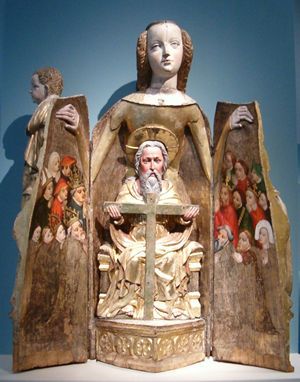oh and the riches keep coming - the procession to St. Margaret's Mass includes the Cistercians who established Hovedøya Abbey on an island off Oslo in 1147 - The original monks were from the monastery in England, Kirkstead Abbey that had only been established in 1139 by a group of 12 monks from the largest and best preserved ruined Cistercian monasteries in England, Fountains Abbey. It seems Hovedøya Abbey, during the medieval period was one of the richest institutions in Norway, holding over 400 properties, including a fishery and timber yards.
Here is an architectural layout for a Cistercian or a Benedictine Abbey
http://seniorlearn.org/forum/index.php?action=post;topic=4658.280;num_replies=286The Abbey is dedicated to St. Edmund, who was king of East Anglia from about 855, that little is known but he was supposedly martyred in Denmark by the Vikings or maybe even the Danes. More important, the Abbey is also dedicated to The Virgin Mary - during the Middle Ages is when the cult to Mary was established.
"The twelfth and thirteenth centuries saw an extraordinary growth of the cult of the Virgin in western Europe, in part inspired by the writings of theologians such as Saint Bernard of Clairvaux (1090–1153), who identified her as the bride of the Song of Songs in the Old Testament. The Virgin was worshipped as the Bride of Christ, Personification of the Church, Queen of Heaven, and Intercessor for the salvation of humankind."
And in the early 14th century comes the
Vierge Ouvrante from Cologne. When closed, the hinged sculpture is of the Virgin nursing the Christ Child, who holds the dove of the Holy Spirit. Her garment opens up, like the wings of a triptych, to reveal in her body the figure of God the Father. He holds the cross, made of two tree trunks, from which the now-missing figure of Christ hung. The flanking wings are painted with scenes from Christ's infancy or Incarnation, that is to say, the embodiment of God the Son in human flesh.

All Cistercian houses were dedicated to the Virgin, under the title of the Assumption, ‘Queen of Heaven and Earth’, and throughout its history the Order was closely identified with its devotion to her cult. Mary was first celebrated in the Cistercian liturgy in 1152. The Little Office of Our Lady was sanctioned as a community prayer in 1185, her votive Mass celebrated on Saturdays from 1220, and by the thirteenth century the Salve Regina, in many ways a defining feature of the Order, was sung at the end of Compline to conclude the liturgical day.
Wow and another bit where the circumstances sound like foreshadowing some of Erlend and Lady Aashild's experiences, even touching symbolically on the death of Erlend's rival, the deceased Arne.
When Saint Bernard's mother dies in France he becomes a Cistercian and three years later, he was sent to establish and build a new abbey also in France. Bernard assisted at the Council of Troyes putting together the outlines of the Rule of the Knights Templar, who soon became the ideal of Christian nobility. Upon the death of Pope Honorius II in 1130, a schism broke out in the Church. Louis VI of France convened a national council of the French bishops, and Bernard was chosen to judge between the rivals for pope. The upshot of this massive travel by Bernard to negotiate between all of Europe's kings and leaders is that Innocence becomes Pope because Anacletus, his rival dies. In 1139, Bernard assisted at the Second Council of the Lateran. Bernard denounced the teachings of Peter Abelard to the pope, who called a council at Sens to settle the matter.
And then the biggie - Following the Christian defeat at the Siege of Edessa, the pope commissioned Bernard to preach the Second Crusade, led by Louis VII of France (his wife is Eleanor of Aquitaine) and Conrad III of Germany, with help from other European nobles. The Second Crusade in an utter failure and during the last years of his life Bernard is saddened by this and the entire responsibility for the Crusade was thrown upon him.